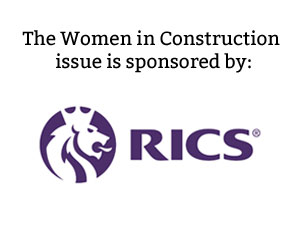Amanda Clack took office as RICS President on 27th June 2016. She joined EY as a partner in August 2015 as the Head of Infrastructure (Advisory) for the UK and Ireland, prior to this having been a partner at another of the Big Four firms of accountants. Qualifying as a quantity surveyor and in project management, Amanda is a Fellow of RICS, the Association for Project Management, the Royal Society of Arts, the Institute of Consulting and the Institute of Management.
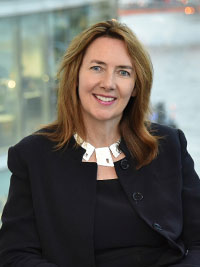
“…there’s lots of opportunities for women. The profession is incredibly embracing. The skills that women have feed particularly well into Chartered Surveying…”
Becoming RICS President

It’s incredibly, incredibly exciting to be RICS President. What a great time to be in a leadership role for the profession! I still can’t quite believe it’s happened if I’m honest. It’s still not feeling like it’s quite real. I’m reassured that it has happened! The inauguration was a fabulous experience.
The year is flying past already – we’re now in September and it feels like there’s so much to do in the time frame we’re working to, but it’s such a privilege to be at the head of the profession.
The themes I’m focusing on are: infrastructure; cities and the war for talent. All of these are resonating anywhere I go in the world.
My career background
A qualified originally as a quantity surveyor. I did my degree on a day release basis over five years, working four days a week and studying one day a week at university. I then went on and did a Master’s degree in Programme Management, again in a part time basis, over two years.
I’ve gradually pushed more and more into management consultancy, and I’m now Head of Infrastructure for the advisory business as a partner for EY within our UK and Ireland practice.
The role of a Chartered Surveyor and why it’s a great career for women

From a female perspective, there’s lots of opportunities for women. The profession is incredibly embracing. The skills that women have feed particularly well into Chartered Surveying; for example attention to detail is something that women are particularly good at. That’s something you need as a Chartered Surveyor.
Surveying as a global passport to opportunity
The fact that it’s so diverse means you can also have lots of different opportunities – whether you want to be working or construction or if you want to be a land surveyor, or if you want to work in an office environment. There’s lots of flexibility. What’s really important is that surveying does matter when you’re looking at land, property, infrastructure, or indeed construction. There’s so many opportunities out there and a huge demand for the skill base.
Once you’ve got that professional qualification, it’s recognised and in demand all over the world. As RICS we have 180,000 members, students and trainees right the way across the globe. We’ve got offices in 27 of the world’s major cities, covering 153 different countries. There’s Chartered Surveyors working and practising in every country around the globe. The potential is there if you want to travel – it’s a global passport to opportunity.
Why diversity is a strategy and a source of competitive advantage in the industry, not an issue
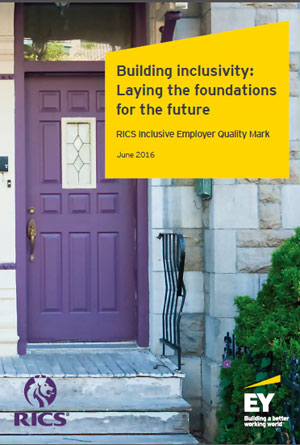
In general, one of the things we found is that there is a real commitment to diversity and inclusion, along with an enthusiasm to continually improve as a sector, but what we are sometimes seeing is a lack of planning, implementation and monitoring required to make real change happen. I think we should support and encourage the strides that are being taken to improve the diversity and inclusion picture.
An example of this would be where you have workforce data monitoring, which allows us to accurately assess the diversity of an organisation’s people – identify priorities and aspirations, and to measure progress. The second area would be things like encouraging participation in the sector through initiatives like employee research groups, having diverse role models, promoting inclusive policies and practices, and increasing visibility of a diverse workforce in external collateral and PR material.
Moving from aspiration to action
Overall, there are a number of key gaps that we need to close as the sector starts to move from aspiration to action. At our diversity and inclusion conference this year, one of the things we asked people to say to camera what that actions they would take away as a result of having come to the conference.
Some of the gaps that need to be closed are things like: Applying scrutiny to all diversity and inclusion activity – including the development of detailed action plans; dedicating delivery resources to the agenda; benchmarking practices against other more mature sectors so we can share leading practice not just in the sector, but also outside it.
It’s also about offering enhanced inclusive approaches, particularly staff retention – this is very important when you start to consider what employee needs are. Improving data capture across all the protected characteristics is very important in order to provide a measurable starting point for review, and most importantly progress.
Driving behavioural change through the Inclusive Employer Quality Mark
That’s what the Building inclusivity: Laying the foundations for the future report did was to provide the first baseline for the sector, by the sector. It gives us that absolute starting point, and that’s where RICS is leading by example with the Inclusive Employer Quality Mark (IEQM), which hopes to drive behavioural change by encouraging firms to look carefully at their employment practices, also putting inclusivity at the heart of what they do.
There’s a lot happening, but there’s the recognition that we need to go further on all of this. It feels like firms are ready to accept that because of this huge war for talent issue, which is one of the things that came through in our RICS Futures work in Our Changing World. The number one thing employers were telling us they were worried about was the war for talent.
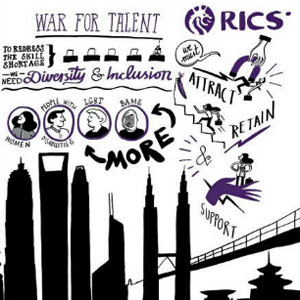
It’s different for smaller organisations to implement but I don’t think it’s any more difficult. When we were looking at the Inclusive Employer Quality Mark we wanted to make sure that there was as much of an opportunity for SMEs to contribute as there was for large firms. We now have over a hundred firms signed up to the Inclusive Employer Quality Mark, which is fantastic! Some of those are in the SME category and some are major firms.
It’s important that we look at it from both perspectives because there are different issues. We have developed a new diversity page that allows companies to input and share leading practice, and this allows larger firms to be able to share ideas with SMEs, and vice versa, so they can take them away and easily start to implement them. RICS has the ambition to be the catalyst for change and facilitate dialogue and cooperation between firms, to ensure we achieve change in the industry.
Making the professional aware of the dangers of unconscious bias
Unconscious bias does continue to plague the industry, and the thing about it being unconscious is you’re not aware of it! These are the barriers that cause problems, not only to the pipeline of talent entering the profession, but also the retention and development within it. That’s because effectively by creating a diverse industry, it’s about encouraging different people into the profession.
Retaining talented individuals is a key challenge and an essential part of business strategy for a large corporate or indeed for an SME, and the industry recognises it, but access to training will differ. Unconscious bias training is essential at all levels of an organisation. A one off session often isn’t sufficient. We need to have continuous training and pushing the message to see a real change in attitude.
There’s some brilliant online training sessions for companies that can’t afford bespoke training. For example, Google and Apple etc. have shared their training sessions on YouTube. I’m a strong advocate of the sharing of best practice. There’s also some free fact books online about tackling unconscious bias. Everyone should take advantage of any free training opportunities that are available and embed it into the culture through sharing.
You can take a free online assessment and literally see for yourself whether you need to do something about unconscious bias because it’s really important that we understand:
1. What it is
2. Where we sit on the spectrum
This means we can then take some personal action. This is as much an individual’s responsibility as it is the corporates’.
We’ve got #SurveyingTheFuture and #LoveSurveying, which are all about people saying why they love surveying. #SurveyingTheFuture is about different types of people from different backgrounds talking about how they came into the profession, what do they do and what they love about their job – that helps different people to see that they too can belong.
It’s really important that you can bring your whole self to work each and every single day, and tackling unconscious bias is at the heart of it.
Accelerating progress towards gender balance construction
I’ve just chaired a cross-profession and industry skills group. Step one: Action is being taken to increase the percentage of women in the construction sector; to say we have made huge strides would probably be an overstatement, but there have been promising developments. We’re still some way off in terms of seeing a significant shift, although, as I mentioned before, much is being done to increase diversity. The truth of the matter is that women are still significantly underrepresented in today’s construction industry.
That means that we need to have more role models at the top, and people who are prepared to inspire others. It’s important that people put themselves forward, particularly when they are in senior leadership roles, so that others can see and aspire to join the industry.

The industry can really help to change these perceptions, however that’s only part of engaging the next generation, who will become the future of our industry. We need to address the skills gap we are facing – it’s expected to get much worse as the industry booms and our population ages.
How RICS is playing our part in changing perceptions
The changes of perception have already begun. We’ve got some highly successful female figures making an impact in the built environment – they’re the role models for our industry and we should celebrate them, and use their successes to shatter the perceptions of construction being only for men.
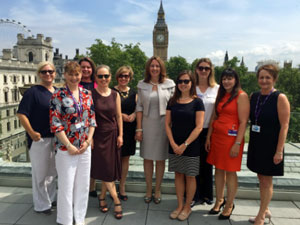
We’ve been promoting Women of the Future – RICS is sponsoring a category in Real Estate, Construction and Infrastructure. The level of entrants that are coming through is outstanding and the shortlisted women are just incredible. We’re then promoting them as role models and spokespeople for the profession.
The Young Surveyor of the Year Awards that we have now is fantastic as well because that celebrates the leading young talent from across the profession. We can then start to promote that with a view to others feeling inspired to want to come into the profession. Quite often, unless you have somebody you know who’s a surveyor you wouldn’t necessarily think of it as a career choice. It’s not something schools would necessarily be promoting.
Going back to my earlier point – surveying gives such a diverse level of opportunity. You can shape your career to suit your needs as you go through life.
We’ve still got a profession where only 13% are female globally, and 24% of our graduate level entrants are female, so it’s starting to change, but we still have a long way to go. Part of it is about messaging back out to young people thinking about starting their career – particularly myth busting with girls about what it’s like to work in construction. A real key part to that is having these role models, and also mentoring as well.
How might Brexit might affect access to skills moving forward
We have a skills shortage within the sector. One of the things with Brexit is that it’s going to heighten awareness around the whole skills issue, and I think one of the ways that we solve that skills issue for the sector is that we have to acknowledge that 50% of the potential workforce is female. How do we get those women choosing our profession? The skills shortage in the construction sector is a consequence of multiple different factors, ranging from the cyclical nature of the economy, to the culture within construction.
Around 270,000 construction sector jobs were lost between 2009-2010 as a result of the recession, and some 430,000 construction workers are set to retire between 2010 and 2020. On top of that, more than 220,000 new recruits will be needed between 2015-2019; that says we’ve got a skills issue. Given the long timescales involved in training new professionals, the short and medium term outlook for the UK to meet its own skills needs is incredibly challenging
The RICS Construction Market Survey data shows that despite the slowdown in growth in Q2, the skills shortages remain as pronounced as they were in the previous quarter, with around 56% of contributors reporting skills shortages. Meanwhile, you’ve got a sector that’s failed to attract diverse new entrants, and therefore hasn’t taken advantage of the talents available within the whole workforce, with women accounting for just 11% of the construction workforce.

So irrespective of Brexit, and new / disruptive technology changing the skills that we’re going to need in the sector, the qualifications will have to reflect new practices, so if these challenges can be met, there is great potential, not only to reduce total labour requirements, for example through offsite construction, but also to engage with a much more diverse workforce as methods of construction increasingly use skills from other industries, such as manufacturing.
The future relationship with the EU can take various forms and I think its impact on the skills needs for the UK has yet to be determined, although restrictions on labour mobility would absolutely add complexity to what’s already a pretty skills constrained labour market.
Coming up next for me and RICS
I’m incredibly excited about the three things I’m focusing on that I mentioned earlier – infrastructure, cities and the war for talent. They really are resonating, whether I’m talking to people wanting to come into the profession, or people already in the profession, or indeed the Government. They are absolutely the right issues and I want to have made a difference in all three areas.
Diversity and inclusion are key for my presidential year – I’m the second female president in RICS’ 148 year history and I’m the 135th President, so now’s a good time to be talking about them.
My programme is incredibly exciting. It includes lots of things in the UK, but also globally. I’ve also join the Lord Mayor’s programme promoting London and tackling infrastructure challenges, including skills gaps, and that’s taken me to China. I’m going to open our second School of the Built Environment in Mumbai, which follows 1,400 people studying at the first School of the Built Environment in New Delhi. I’ll be going out to India in November.

October sees me in Rio, where I’m with the ICEC [International Cost Engineering Council] looking at our international construction measurement standard. We’re working with a coalition of around 40 organisations – professional groups from all over the world that are coming together to drive a standard in international construction measurement.
I’m also chairing lots of groups, forums and discussions, particularly around my three key themes. Behind all that I’ve got a fantastic staff team. The Governing Council here at RICS is also very much behind the strategy driving the Institution forward. My employer, EY has been amazing. I couldn’t do it without their support.
I’ve very fortunate and I hope to be able to use that to give back to the rest of my profession.
To keep up to date with diversity and inclusion in the industry, please sign up to the RICS’ monthly dedicated newsletter. http://news.rics.org/public/m/diversitymatterssub
https://twitter.com/amanda_clack
https://www.facebook.com/ricssurveyors
https://www.linkedin.com/company/rics


